Sunday School General President Gives LDS Air Force Graduates 8 Principles for Receiving Revelation
Contributed By Peggy Kinnaird, Church News contributor
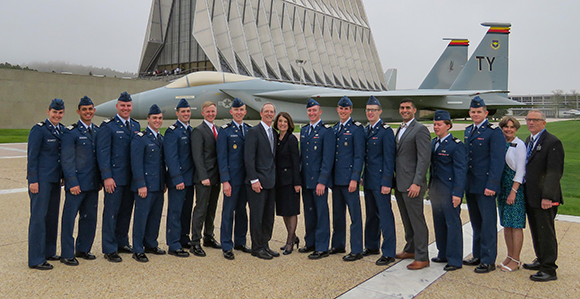
Graduating seniors stand with guest speaker Brother Tad R. Callister and his wife, Sister Kathryn S. Callister, along with Brother and Sister Lee, before the third annual Baccalaureate Service at the USAFA. Photo by Vern Pitcher.
Article Highlights
- God is desirous and even eager to reveal His mind to us.
- Each person is entitled to revelation within his or her own rights and responsibilities.
- Reason and revelation work as partners in a larger process of doing the Lord’s work.
Revelation can be one’s “spiritual North Star,” Brother Tad R. Callister, Sunday School General President, told LDS cadets graduating from the United States Air Force Academy on Sunday, May 20.
A total of 24 graduates, including three women, are members of The Church of Jesus Christ of Latter-day Saints.
The traditional Baccalaureate Service kicked off a full week of activities for graduates and their friends and families on the Colorado Springs campus. The third annual LDS Baccalaureate Service on Sunday immediately followed the Buddhist, Catholic, and Protestant Baccalaureate Services held earlier that day.
The service is intended to provide a spiritual component along with the celebrated academic achievement of the graduates.
Eight principles in receiving personal revelation
In his address, Brother Callister inspired the graduates to remember eight principles in receiving personal revelation.
First, “God is desirous and even eager to reveal His mind to us,” he said.
Second, he stressed that each person is entitled to revelation within his or her own rights and responsibilities. Whether a person is a teacher, student or companion, “God will not leave us alone.”
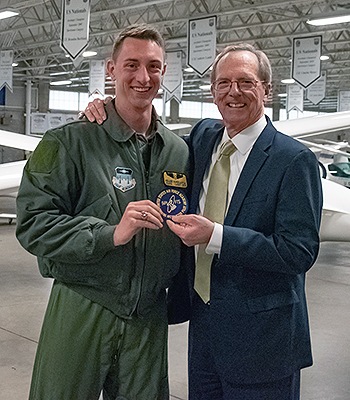
Cadet 2nd Class Holden Hardcastle, who is a soaring instructor pilot, presents Brother Tad R. Callister with an Air Force commemorative patch. Photo by Vern Pitcher.

Brother Tad R. Callister, Sunday School General President, addresses the LDS cadets, who are “men and women of character, honor, and integrity,” during the USAFA Baccalaureate Service on Sunday, May 20. Photo by Vern Pitcher.
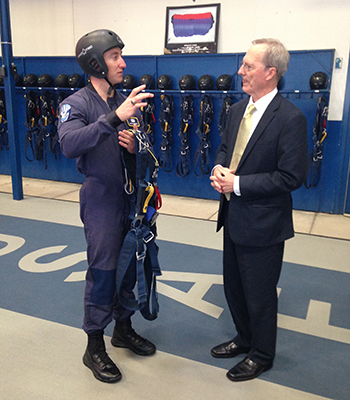
Nathan Brooks, an LDS graduating Cadet 1st Class, who has made a total of 543 jumps while training at the USAFA, shows Brother Tad R. Callister the various straps and deploying mechanisms attached to a parachute harness. Photo by Vern Pitcher.
He followed up with a third principle: no person is entitled to receive revelation outside of his or her rights and responsibilities. Brother Callister said this was a problem in the early days of the Church, with many Saints not understanding or agreeing with this principle and trying to tell the prophet what to do.
“If someone obtains revelation for a bishop or prophet, they are not speaking on behalf of the Lord,” he said. “God does not operate through multiple channels.”
The fourth principle he spoke of is how reason and revelation work as partners in a larger process of doing the Lord’s work. He quoted from Doctrine and Covenants 9:7–8:
“Behold, you have not understood; you have supposed that I would give it unto you, when you took no thought save it was to ask me.
“But, behold, I say unto you, that you must study it out in your mind; then you must ask me if it be right, and if it is right I will cause that your bosom shall burn within you; therefore, you shall feel that it is right.”
The fifth principle states that if a person is trying their best and has not yet received any revelation, then they should act upon their own best judgement. He gave examples of various day-to-day activities in which it is not necessary to counsel with the Lord and said everyone has their agency to choose.
“With increased agency comes increased spiritual growth. Acting on our best judgment is sometimes sufficient in itself,” he said.
The sixth principle is that although reason is important, sometimes revelation may conflict with reason. He recounted a story of a finance major who could not live the law of tithing because his calculations did not add up. For him, it was mathematically impossible until a home teacher gave him a blessing and told him that if he lived the law of tithing, he would never experience a day of want in his life. The student decided to choose revelation over reason.
Brother Callister said the seventh principle is that the degree of revelation is relative to personal spiritual integrity; people must look at their own lifestyles and make changes if necessary.
The eighth and final principle is there may be a price tag to receiving revelation, meaning that people should do the work necessary. He spoke of Alma the Younger, who had already seen an angel of God but wanted a spiritual confirmation. Brother Callister read Alma 5:46:
“Behold, I say unto you they are made known unto me by the Holy Spirit of God. Behold, I have fasted and prayed many days that I might know these things of myself. And now I do know of myself that they are true; for the Lord God hath made them manifest unto me by his Holy Spirit; and this is the spirit of revelation which is in me.”
Brother Callister concluded his address by stating the necessary steps to receiving personal revelation, which include sincere prayer in the morning and evening, studying and pondering the scriptures, an honest fast with purpose, controlling thoughts, and attending the temple often.
“I hope we know how desirous the Lord is to guide our lives. May it [revelation] be our spiritual North Star,” he said.
Cortney Porter, a graduate and captain of the women’s basketball team, said she enjoyed Brother Callister’s talk and was reminded of a recent conference address where President Nelson said personal revelation can be very important, especially in the upcoming years.
“It’s so amazing to know that God will speak to us and He is so willing,” she said.
Porter is from Ogden, Utah, and was recruited from Bonneville High School by the USAFA during her junior year. After graduation she will be a force support officer at Dover Air Force Base in Delaware.
Jonson Crandall, a graduating senior and Cadet 1st Class, said he enjoyed Brother Callister’s talk, especially hearing that if a person hasn’t received revelation then they must act on their best judgment. “That is why God has given us reasoning abilities,” he said.
Crandall, from Oakley, Utah, said using reason was how he decided to return to the Air Force Academy after his mission to Taichung, Taiwan. At first, he wasn’t allowed to return due to an inadequate grade in calculus; then, after spending a year at Dixie University trying to make up the grade, he still wasn’t allowed back.
He decided to apply one more time after another year at Dixie and was finally allowed back into the academy. For Crandall, it’s been a long road from basic training eight years ago in 2010.
“My biggest takeaway from Brother Callister’s address was the Lord puts you where He knows you’re supposed to be even though you don’t understand it at the time,” he said.
Jonson Crandall’s brother, Connor, is also graduating from USAFA. His major is systems engineering, and he explained his capstone project to the Callisters on a tour of campus on Saturday, May 19.
Each cadet is required to take a capstone class and finish a project that is devoted to applying the principles that have been learned over the past four years. Conner Crandall ran tests for various companies that developed time-saving software to bring Air Battle Mission Planning into the 21st century. He used the futuristic Microsoft HoloLens to test new software from Air Force Research Labs, Lockhead Martin, and Tier1 Performance.
The Callisters also toured the Air Force Academy’s glider hanger, which houses 28 gliders used for cadet pilot training. They were also given demonstrations by graduating senior Nathan Brooks (C1C) and Joshua Rackham (C2C) on jumping and releasing a parachute on a standard sky dive and a malfunctioning sky dive.
The Callisters were impressed by each of the cadets after the tour.
“They are men and women of character, honor, and integrity,” Brother Callister said.
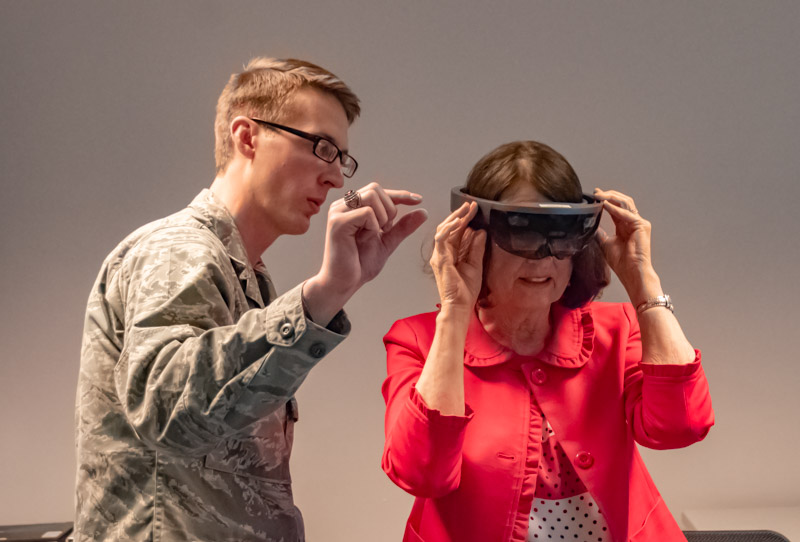
Connor Crandall demonstrates to Sister Kathryn S. Callister how to squeeze fingers together in the air to control the windows display on the screen of the Microsoft HoloLens that she is wearing. Photo by Vern Pitcher.

Brother Tad R. Callister gets behind the controls of a practice glider during a tour at USAFA on Saturday, May 19. Photo by Vern Pitcher.
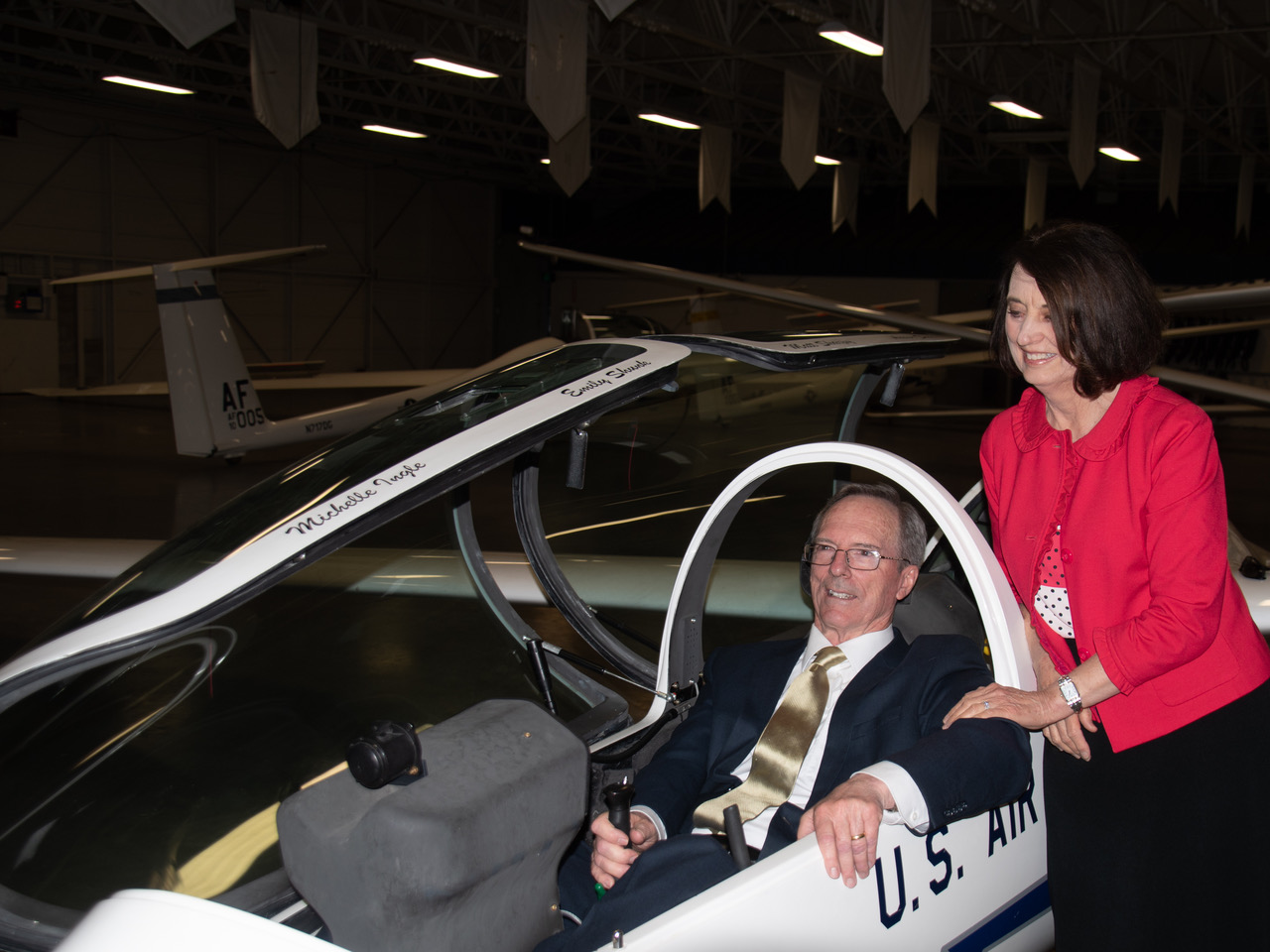
Sister Kathryn S. Callister watches in anticipation as Brother Callister takes the controls of a practice glider used to train future pilots at USAFA. Photo by Vern Pitcher.

Brother Tad R. Callister shows the special unit coin presented to graduating seniors during a reception held prior to the baccalaureate service on May 20. Photo by Vern Pitcher.
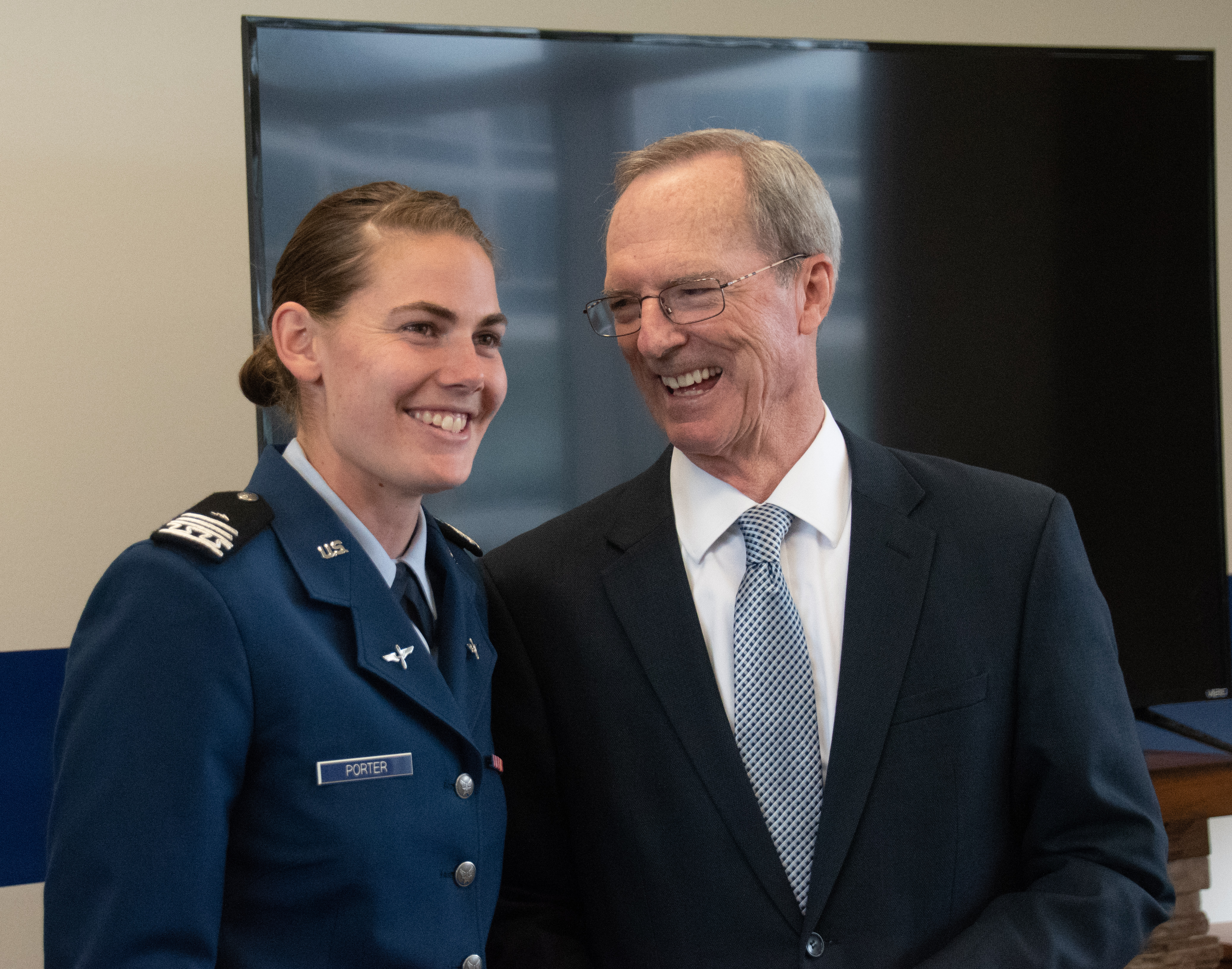
Brother Tad R. Callister presents Cortney Porter (C1C) with a unit coin that reminds her to pray always. Photo by Vern Pitcher.

Dr. Joseph Galema, cadet chapel guest organist, fills the iconic USAFA chapel with the familiar hymn “How Firm a Foundation.” Photo by Vern Pitcher.

Brother John M. Stoffey, LDS Cadet Choir accompanist, and violinist Jonah Angus (C2C) join the choir in a stirring rendition of “Come, Thou Fount of Every Blessing.” Photo by Vern Pitcher.

Connor Crandall, LDS graduating senior, assists Brother Tad R. Callister with the Microsoft HoloLens, which displays the mission planning software that is the basis for his capstone project. Photo by Vern Pitcher.

Graduating seniors stand with guest speaker Brother Tad R. Callister and his wife, Sister Kathryn S. Callister, along with Brother and Sister Lee, before the third annual Baccalaureate Service at the USAFA. Photo by Vern Pitcher.

Brother Tad R. Callister is briefed on the purpose of the Polaris Hall Honor Room at the USAFA, where a case may be heard regarding a fellow cadet’s practices against the honor code. Photo by Vern Pitcher.

Cadet 3rd Class Patricia Nieves Rosich and Cadet 3rd Class Autumn Wolfgramm attend a luncheon before a question-and-answer session with the Callisters. Photo by Vern Pitcher.

A group of LDS cadets pose together before the question-and-answer session with Brother and Sister Callister. Photo by Vern Pitcher.

A crowd awaits the third annual Baccalaureate Service on May 20, 2018. Photo by Vern Pitcher.
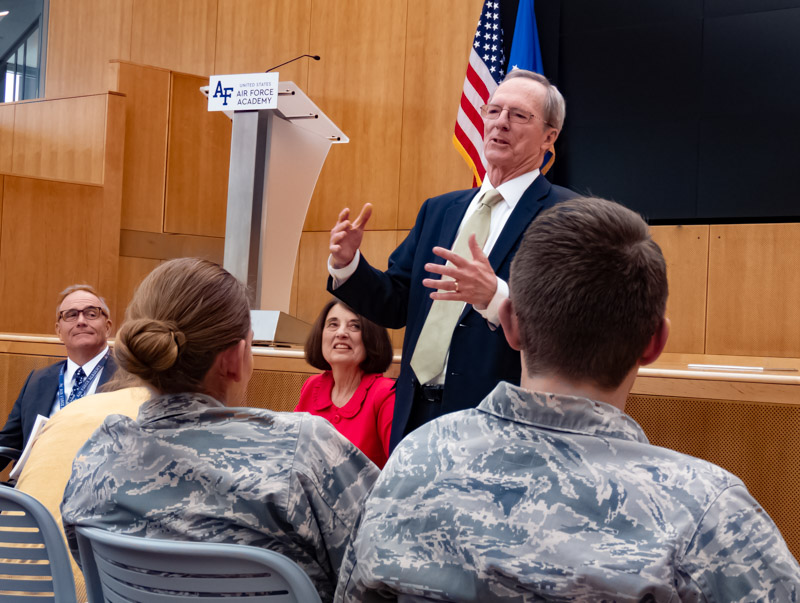
Brother Tad R. Callister talks about marriage and successful time management, which were top concerns raised by cadets during a question-and-answer period on Saturday, May 19, 2018. Photo by Vern Pitcher.
